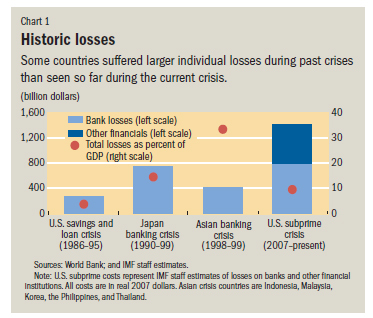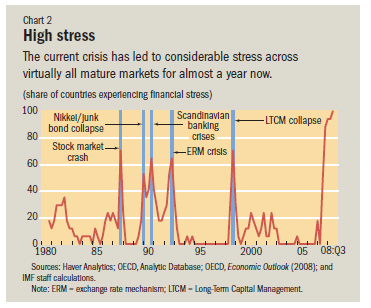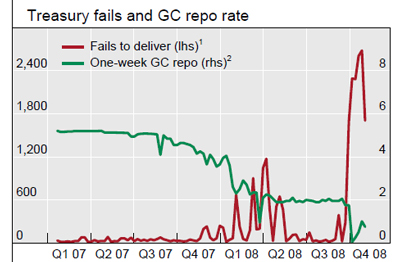The fund handsomely outperfomed its benchmark in November, but was dragged down by an unprecedented decline in preferred share prices. The immense volatility of the market is leading to most unusual trading opportunities.
How bad and how unprecedented was November? The BMOCM-50 Index was down 10.70%. Taking data from the BMOCM-50, I can say it was the worst month I have on record, with records beginning on December 31, 1992. And, you might well ask, what was the second-worst month? October 2008, down 8.16%. Third-worst? August, 1998 (Russian crisis) down a mere 4.51%.
In fact, of the twelve worst months since 1992-12-31, six have been in the last year.
The fund’s price at November 28, 2008 was $7.0106, after expenses, but before fees (which are billed individually to each client).
| Returns to November 28, 2008 |
| Period |
MAPF |
Index |
CPD
according to
Claymore |
| One Month |
-9.24% |
-10.70% |
-11.06% |
| Three Months |
-17.07% |
-20.11% |
-19.85% |
| One Year |
-14.15% |
-20.93% |
-22.79% |
| Two Years (annualized) |
-9.69% |
-14.04% |
|
| Three Years (annualized) |
-4.55% |
-8.29% |
|
| Four Years (annualized) |
-1.92% |
-5.19% |
|
| Five Years (annualized) |
+1.23% |
-3.03% |
|
| Six Years (annualized) |
+5.62% |
-1.33% |
|
| Seven Years (annualized) |
+4.56% |
-0.78% |
|
| The Index is the BMO-CM “50” |
| CPD Returns are for the NAV and are after all fees and expenses. |
Returns assume reinvestment of dividends, and are shown after expenses but before fees. Past performance is not a guarantee of future performance. You can lose money investing in Malachite Aggressive Preferred Fund or any other fund. For more information, see the fund’s main page.
The yields available on high quality preferred shares remain elevated, which is reflected in the current estimate of sustainable income.
| Calculation of MAPF Sustainable Income Per Unit |
| Month |
NAVPU |
Portfolio
Average
YTW |
Leverage
Divisor |
Securities
Average
YTW |
Sustainable
Income |
| June, 2007 |
9.3114 |
5.16% |
1.03 |
5.01% |
0.4665 |
| September |
9.1489 |
5.35% |
0.98 |
5.46% |
0.4995 |
| December, 2007 |
9.0070 |
5.53% |
0.942 |
5.87% |
0.5288 |
| March, 2008 |
8.8512 |
6.17% |
1.047 |
5.89% |
0.5216 |
| June |
8.3419 |
6.034% |
0.952 |
6.338% |
$0.5287 |
| September |
8.1886 |
7.108% |
0.969 |
7.335% |
$0.6006 |
| November, 2008 |
7.0106 |
11.000% |
1.001 |
11.001% |
$0.7712 |
NAVPU is shown after quarterly distributions.
“Portfolio YTW” includes cash (or margin borrowing), with an assumed interest rate of 0.00%
“Securities YTW” divides “Portfolio YTW” by the “Leverage Divisor” to show the average YTW on the securities held; this assumes that the cash is invested in (or raised from) all securities held, in proportion to their holdings.
“Sustainable Income” is the best available estimate of the fund’s dividend income per unit, before fees and expenses. |
The fund has positions in three “Split Share” preferreds – terribly out of fashion at this time and trading at yields higher than the perpetuals – which, as explained in August results in the calculation being rendered somewhat suspect. If these positions were sold – at the closing bid on 11/28 – and all cash reinvested in rest of the portfolio, the resultant portfolio would yield 8.22% and the estimated sustainable dividend per unit (before fees and expenses) would be $0.5763; significantly less than the figure calculated above, but still an increase from last month’s adjusted figure and continuing the long-term upward trend.
The current situation whereby investment-grade SplitShare preferreds yield more than PerpetualDiscounts cannot last forever, and it may be anticipated that the calculated Sustainable will fall towards the adjusted figure of $0.5763 … the current calculation assumes that the yield will last forever, rather than the two or three years remaining until the maturity of the SplitShares. On the other hand, it is possible – unlikely, perhaps, in the current climate, but possible – that the yield on the split shares will fall so rapidly that profits may be taken as a capital gain in the near term and reinvested at sustainable yields close to the assumed level of 8.22%, which would lock in the currently estimated sustainable yield. I am not sure how the analysis may be best presented; perhaps at some point I will recalculate all the data using a sustainable yield equal to the PerpetualDiscount index.
It will be noted that if there was no trading in the portfolio, one would expect the sustainable yield to be constant (before fees and expenses). The success of the fund’s trading is showing up in
- the very good performance against the index
- the long term increases in sustainable income per unit
As has been noted, the fund has maintained a credit quality equal to or better than the index; outperformance is due to constant exploitation of trading anomalies.
Trading in November continued to be heavy, with portfolio turnover at about 175%. Most of these trades were not just intra-sector, but intra-issuer; that is, between similar issues of the same issuer, notably the PerpetualDiscount issues of CM, BMO and SLF. These trades were, in aggregate, highly profitable.
A major trade was executed from PerpetualDiscounts into SplitShares when – against all reason – the split share with a short term maturity and well-buffered against default underperformed the PerpetualDiscount index. This trade – into FFN.PR.A; discussed in the post on portfolio composition – is not yet profitable, but I am confident that it will become so in the near future.
Of greater interest – and greater profitability, so far – was the November 24 trade from WFS.PR.A to FBS.PR.B:
Post-Mortem
WFS.PR.A to FBS.PR.B |
| Date |
WFS.PR.A |
FBS.PR.B |
| 10/31 |
7.71
Yield: 16.57% |
8.70
Yield: 9.99% |
Trade, 11/24
Net of Commission |
7.735 |
7.024 |
| 11/28 |
7.80
Yield: 16.59%
No Dividends |
7.49
Yield: 15.39%
Earned Dividend $0.11875 |
The position in WFS.PR.A was largely established in July, with smaller purchases and sales since then. The largest single day’s trade was a purchase of 6,800 shares on July 9, funded by a sale of GWO.PR.G:
Post-Mortem:
GWO.PR.G to WFS.PR.A |
| Date |
GWO.PR.G |
WFS.PR.A |
Trade
2008-7-9 |
Sold
21.31 |
Bought
9.08 |
Closing
Bid
11/24 |
14.51 |
7.88 |
| Dividends |
Missed
$0.325 |
Earned
$0.13125 |
Most satisfactory! It should be noted that trades both in and out of GWO.PR.G have been performed against different issues as the market allowed in the interim.
At some point – and I won’t guess when that time will be! – the market will cease its decline and, probably, return to its normal levels of between 100bp and 150bp above long term corporates, which in turn will return to more normal levels against long term Canadas. This could happen extremely quickly and attempting to time the market is folly. At the moment, however, people are scared, the market is sloppy and trading opportunities abound.
The absolute performance of the fund is terrible, but the performance relative to the index and tradeable benchmark is superb. The sustainable yield – however calculated – is increasing. As the market recovers – or even stabilizes! – the steady drip, drip, drip of dividends will make itself felt in long-term returns.


